English
Castellano
Català
The Summit Mine - Montana
Author: Chris Tucker
Content by courtesy of : http://www.christuckerminerals.com/
Reproduction of text and photos prohibited without permission of author.
The Summit mine is located in the southern portion of the Radersburg mining district in Broadwater County, Montana. The Summit is the source of the finest hemimorphite specimens in the United States as well as a number of other secondary minerals. The mine lies several miles southwest of Radersburg on the southeast flank of a broad anticline that rises to the west over the Elkhorn Mountains. For the most part, the early history of the Summit has been lost to time. The mine is only briefly mentioned in the literature concerning the area and early county records are spotty at best. Reportedly the mine was discovered in 1887 and saw intermittent activity until recent years. In its infancy, the Summit was a source of silver-lead ores; towards the end of its productive history the Summit also produced copper and zinc. The mine has also been mistakenly called both the Blackhawk and the Montana Silver Star, these names should be discouraged.
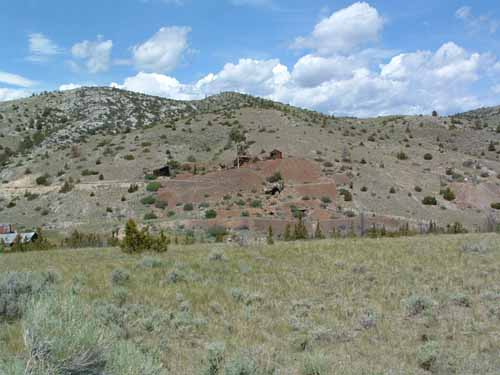
The Summit mine as seen from the south.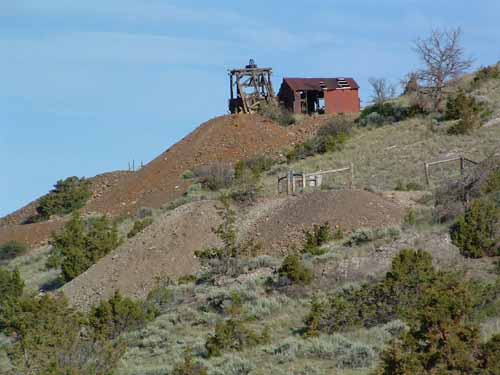
The headframe and compressor house of the Summit.
Development at the mine consists of a main single compartment shaft, two shallow vertical shafts, two short adits, and surface structures. The mine explored a replacement body confined to favorable bedding planes in uplifted Mississippian Madison Limestone. The main shaft explores this ore body to a depth of 600 feet. The shaft ranges from vertical to steeply inclined; in places the shaft has been enlarged by stoping.
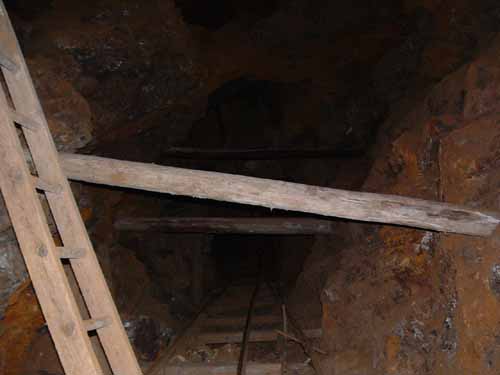
Looking down the shaft from about three hundred feet below the collar.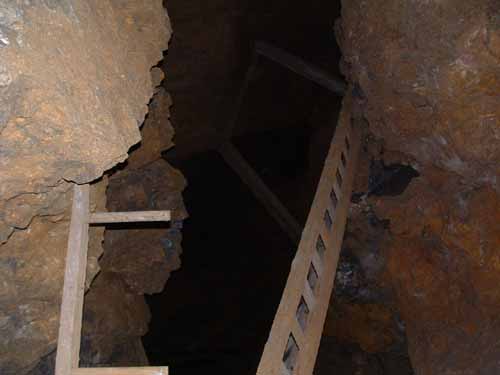
Looking up into stoped workings, about 350ft from the surface.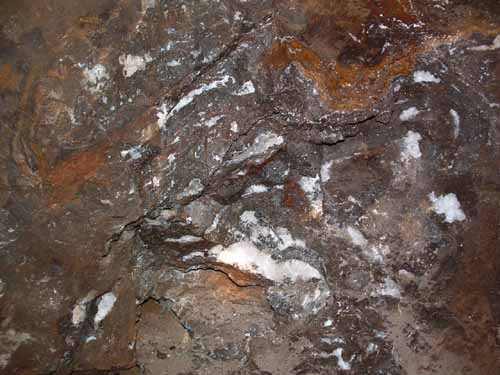
Typical exposure of hemimorphite bearing vugs.
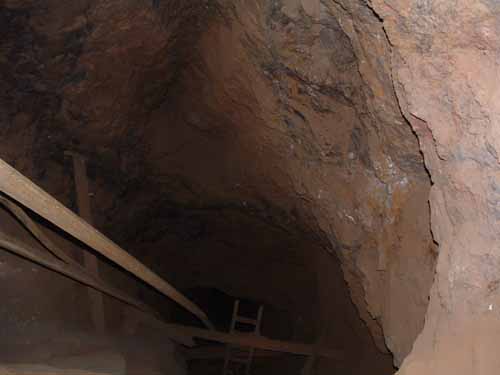
Looking down the shaft near the bottom, note the partially collected hemimorphite vug on the right rib. Consider that all the hemimorphite specimens came from below this point and were packed up 500 feet of rope and ladders.
The Minerals
Aragonite
Colorless crystals of aragonite are fairly common and widespread throughout the mine. The crystals rarely exceed 1cm in length.Aurichalcite
Pale tufts of aurichalcite have been found with wulfenite and hemimorphite in a narrow fracture about half way to the bottom of the mine. The aurichalcite crystals reach a few millimeters in size.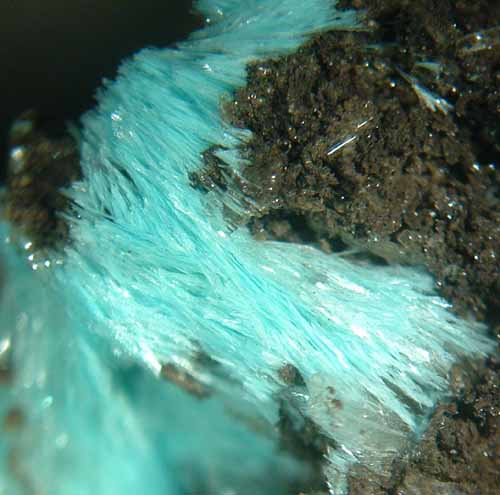
Aurichalcite, 2 mm across.
Barite
Massive white barite is locally present; the barite is coarsely crystalline and occasionally forms the matrix of specimens.Calcite
Calcite is widespread throughout the mine. Colorless to white calcite crystals can be found lining vugs and fractures. Calcite is commonly the last mineral to have formed.Cerussite
Colorless to grey cerussite crystals to 6cm have been found in localized areas. The crystals are generally crude and rounded although sharp colorless microcrystals have been found.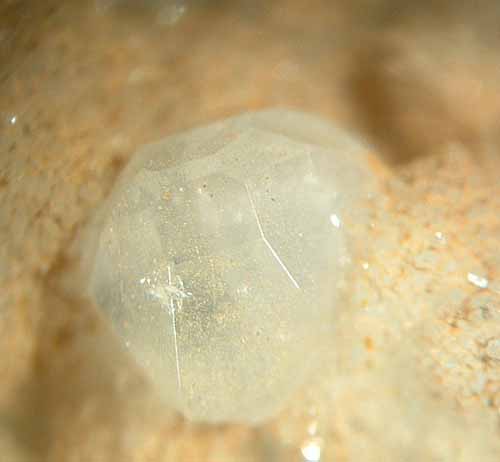
Cerussite, 3 mm across.
Chalcopyrite
A single chalcopyrite crystal was found in massive galena.Chlorargyrite
Crude crystals of yellow-green chlorargyrite have been recovered from the lower reaches of the mine. The crystals rarely exceed 4mm and generally have a "melted" appearance. Chlorargyrite has been found with both residual sulfides and hemimorphite.
Chlorargyrite with hemimorphite, 4 mm across.
Descloizite
Descloizite occurs throughout the mine and is locally plentiful. The crystals are generally sharp and vary in color from red to green to black, larger crystals tend to be distorted. Sharp rosettes of blood-red descloizite make striking specimens.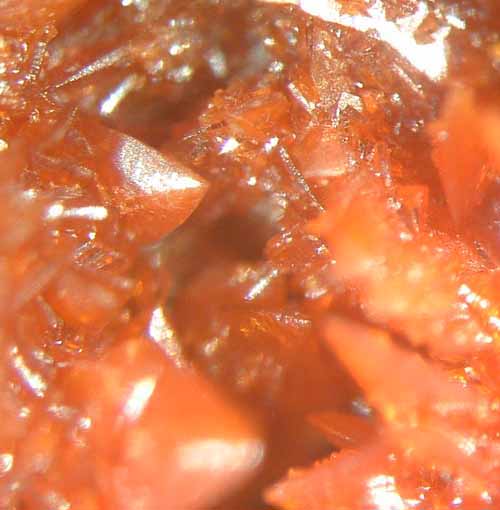
Descloizite crystals, the largest is 2mm long.
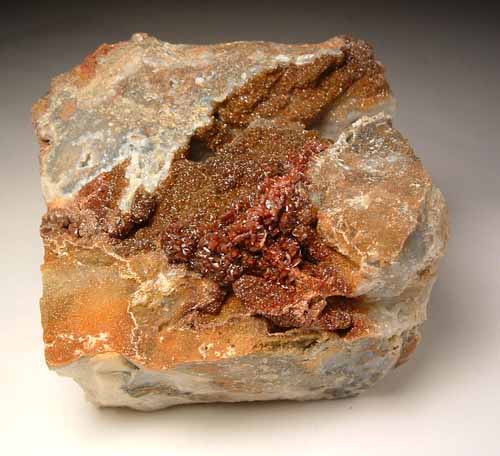
Descloizite, 9 cm across.
Fluorite
Fluorite is rarely found and is one of the earliest minerals to have formed and is always massive. In the back of one small stope several tons of massive purple fluorite occurs with secondary copper minerals.Galena
Galena has been found as residual pieces and occasionally forms the matrix for secondary lead minerals.Gold
Historic documents report a small quantity of gold being present in the ore. Likely, if a sizable ore sample was to be crushed and panned, free gold would be obtained.Hemimorphite
The Summit mine has produced some of the finest hemimorphite in the United States. Lustrous crystals which vary from colorless to snow white and rarely a faint blue reach 12 cm in length and 6 cm across the termination. Often forming attractive groups from thumbnails to cabinet specimens 20 cm across, occasionally associated with several other secondary silver, lead, copper, and zinc minerals. The larger hemimorphite crystals are simple and have a chisel like habit while the smaller microcrystals tend to be more complex. Fan shaped groups and divergent clusters, so common for the species, are abundant.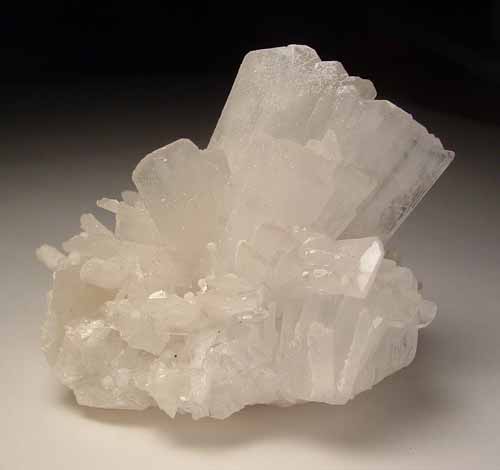
Hemimorphite, 7 cm across.
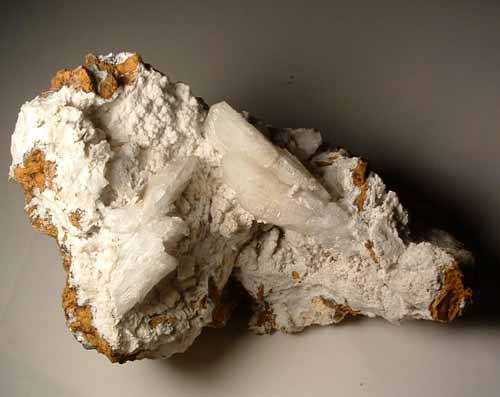
Hemimorphite, 20 cm across.
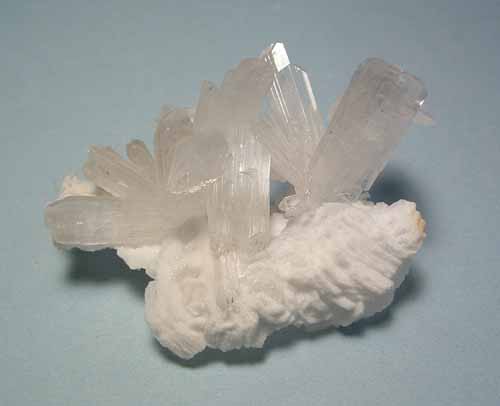
Hemimorphite on quartz epimorphs of an unknown mineral, 6 cm across.
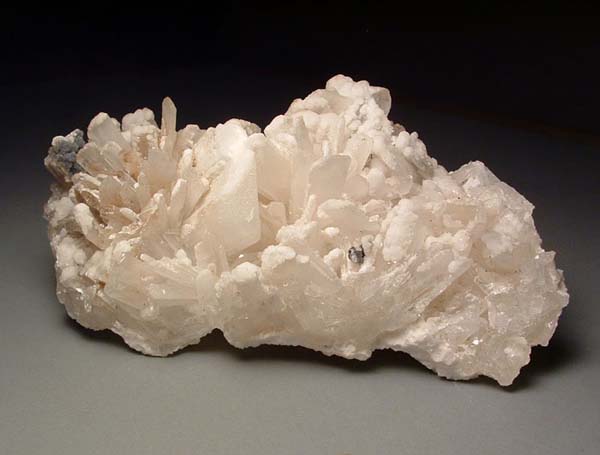
Hemimorphite with calcite, 14 cm across.
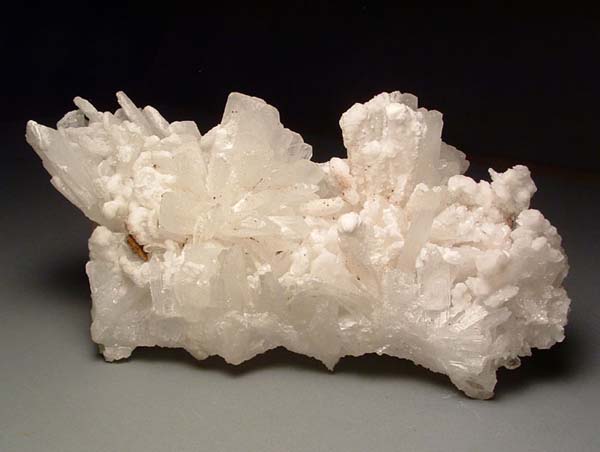
Hemimorphite with calcite, 12.5 cm across.
Hydrozincite
Much powdery white material is found with hemimorphite, it is believed to be hydrozincite but its identity has not been confirmed.Mimetite
Microcrystals of mimetite are common, often occurring as simple elongated hexagonal prisms with a multitude of pyramidal faces in shades of yellow. When found with wulfenite, the mimetite is often red to red-orange in color and forms globular rounded crystal groups. White crystals have been found along with yellow crystals with a white core. A single specimen has been found with mimetite forming crude pseudomorphs of cerussite.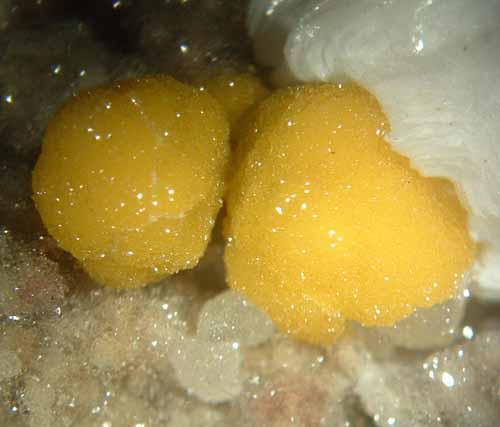
Mimetite pseudomorphs of cerussite with calcite, 1 cm across.
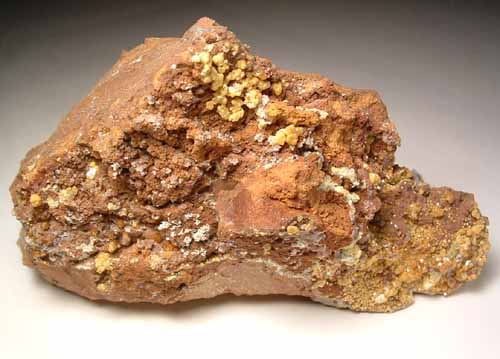
Mimetite, 11.5 cm.
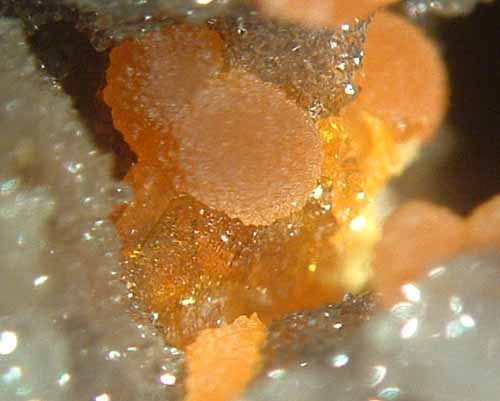
Mimetite on wulfenite, 2 mm.
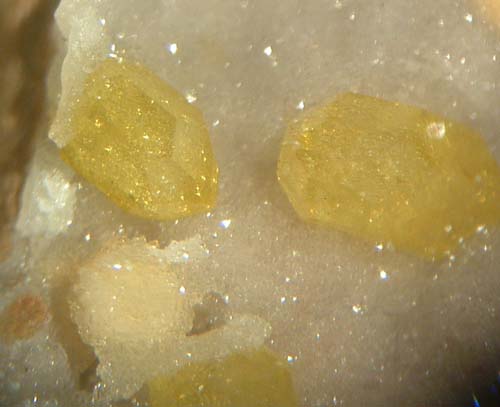
Mimetite, 6 mm across.
Mottramite
Pale green crystals of mottramite have been found growing on large blocky dark red descloizite crystals from one isolated area of the mine.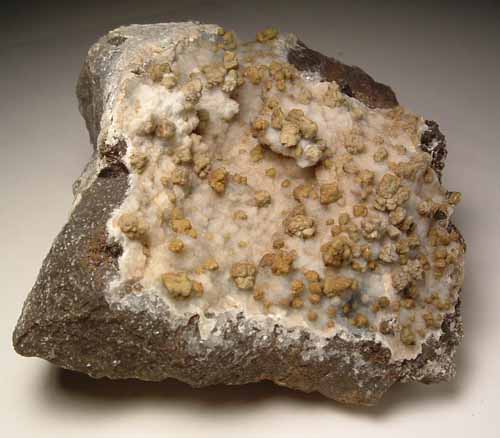
Mottramite on descloizite, 9 cm.
Plattnerite
Sharp microcrystals of plattnerite are often found growing on other lead minerals. The plattnerite crystals are often lustrous and rarely exhibit twinning.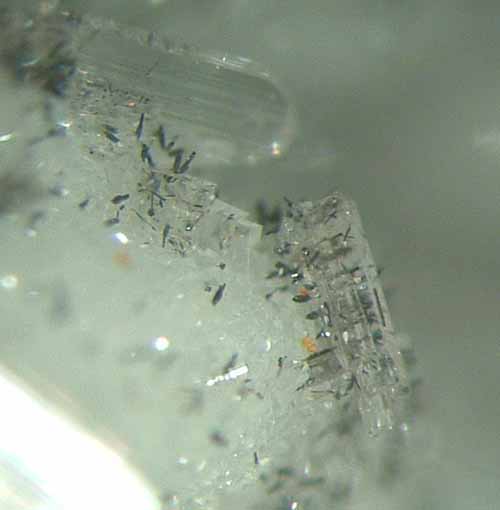
Plattnerite with hemimorphite, largest hemimorphite is 2 mm long.
Pyrite
Rare massive pyrite has been encountered in the underground workings.Quartz
Quartz occurs throughout the mine and is a common cavity lining. Quartz also frequently forms both pseudomorph of hemimorphite and epimorphs of several other minerals including calcite, descloizite, hemimorphite, cerussite, and possibly smithsonite and polybasite. Quartz is also found in epitactic growth with hemimorphite; the Summit is one of the localities in the world where such a relationship is known to occur.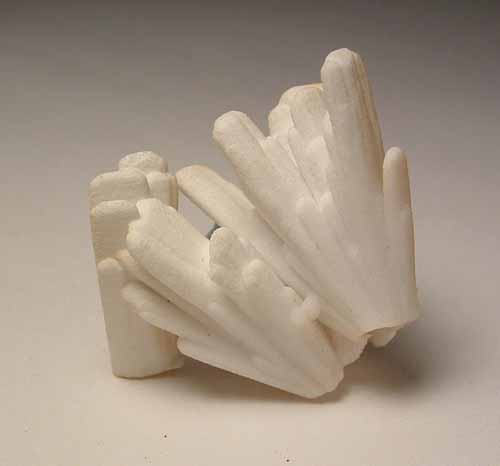
Quartz epimorph of hemimorphite, 4 cm.
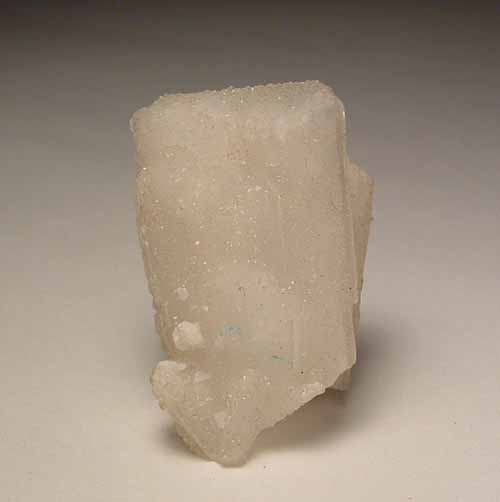
Quartz epitactic on hemimorphite, 3.3 cm tall.
Rosasite
Rosasite is locally plentiful in the mine. Often the rosasite occurs as simple rounded balls that reach as 1 cm across. More rarely coarsely crystalline rosasite microcrystals are found forming small groups, the Summit mine is one of the few localities in the world where individual rosasite crystals can be found. Hemimorphite is often encountered with rosasite.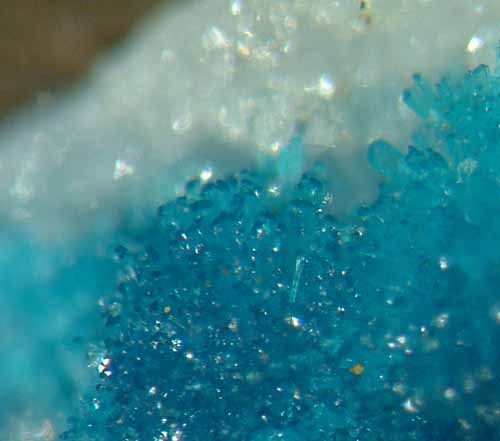
Acicular rosasite microcrystals, 1 mm across.
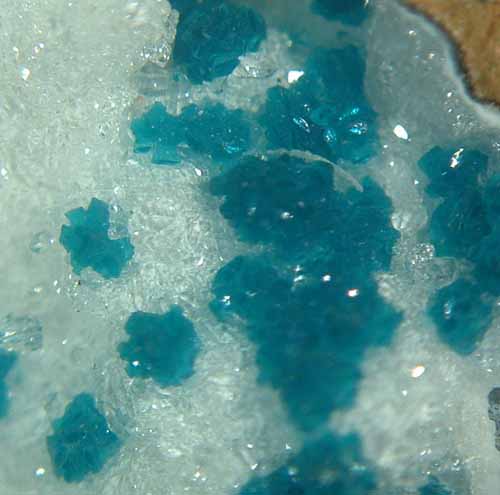
Thick blocky rosasite microcrystals, 3 mm across.
Scorodite
A single collector references scorodite from the mine, its occurrence can not be verified and is presence is suspect.Smithsonite
Smithsonite was one of the major ore minerals at the mine. The smithsonite is commonly the massive dry bone variety. Likely some of the "calcite" in the mine is, in part, smithsonite.Sphalerite
Near the lower reaches of the mine sphalerite has been found in massive galena.Vanadinite
Dull red-orange vanadinite is sparingly present. The crystals are generally simple elongated hexagonal prisms.Willemite
Willemite has been found as colorless microcrystals in dump material. Willemite has not been found in situ and its presence must be considered suspect.Wulfenite
Wulfenite is uncommon in the mine, although locally plentiful areas have been found. Thin transparent yellow-orange tabular crystals to 5 mm occur sparingly throughout the mine. In the near surface workings, a single narrow fracture was encountered that contained microcrystals of tabular yellow wulfenite in association with vivid red descloizite and dull yellow mimetite. One small mineralized area produced several transparent tabular crystals of wulfenite with slight pyramidal faces, the largest being 2 cm. Frequently crystals of wulfenite have microcrystals of plattnerite growing almost exclusively on the pedion. In the lower portion of the mine a single pocket was encountered that contained hemimorphite crystals to 4 cm. Scattered about the hemimorphite were several blocky pseudocubic orange wulfenite crystals to 8 mm. Although the pocket was small, the few specimens that it produced are striking and give promise to future discoveries.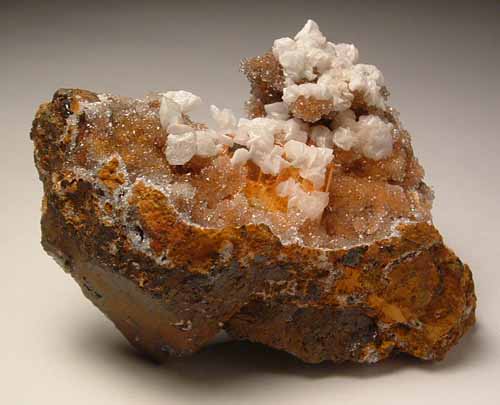
Wulfenite with calcite on quartz, 7.2 cm.
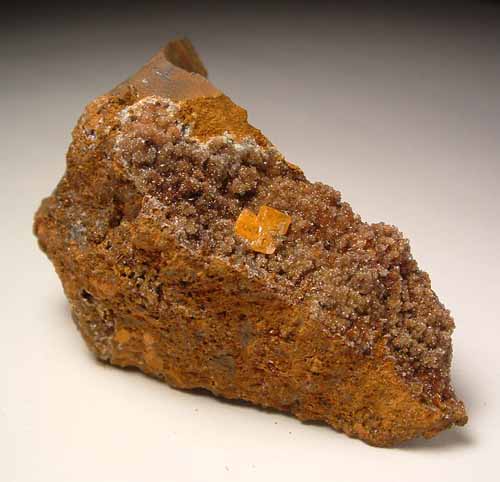
Wulfenite on quartz, 7 cm across.
Information | Mineral photos | VIDEOS | Articles | Fairs | Web directory | Classified ads | Minerals Books | Shop




